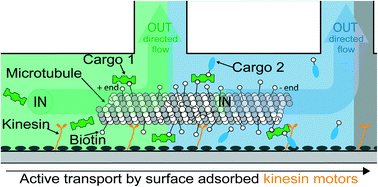Discontinued Research on Nanoshuttles
Imagine you could build nanoscale machines by assembling single molecules. Imagine you could use these machines as tools to create complex materials, transport single molecules, repair tiny defects on surfaces or to store and retrieve information. These machines would be able to perform similar tasks as the machines we know from our everyday lives: assembly lines, trains, machine shops or computers – with the big difference, that they would work on a scale that is multiple orders of magnitude smaller.
Transport by motor protein kinesin
For all of these tasks, transport is the prerequisite. We are attempting to build a nanoscale transport device, which is inspired by nature: cells have evolved an extremely efficient and versatile transport system. In this system specialized motor proteins – amongst others kinesin – actively carry proteins, vesicles or even complete organelles along cytoskeletal filaments.
The inverted motility assay

To integrate kinesin motor proteins and microtubule filaments into nanoscale transport devices, we employ the inverted motility assay. In this geometry, kinesin motor proteins adsorbed onto a surface actively propel hollow, rod-like microtubules forward, which then serve as ‘molecular shuttles’. For the preparation of the inverted motility assay, a surface is pre-coated with a supporting layer of casein into which kinesin can functionally integrate (Figure 1).
Figure 1 Scheme of the inverted motility assay and the diffusion chamber in which it is observed. Figure by external page Christian Brunner
Molecular shuttles
Microtubules are added and the active transport is then fueled by adenosine triphosphate (ATP). The molecular shuttles provide an actively driven transport system, which operates at the frontier between diffusion and pressure driven flow. Direction of movement can be controlled.
